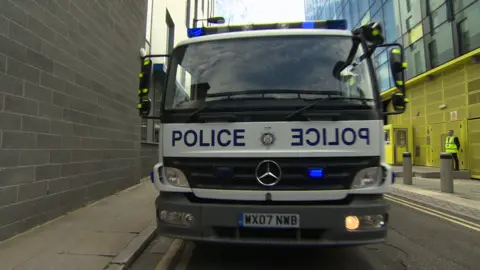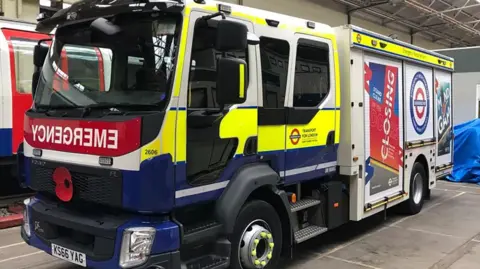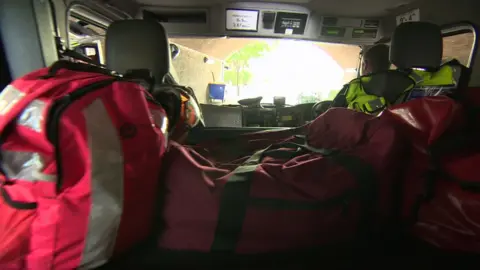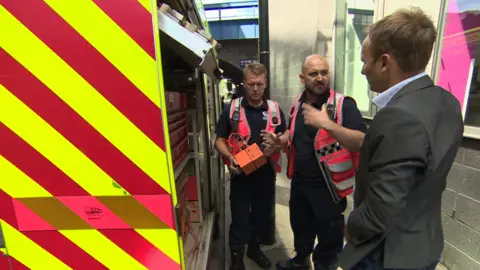Key 7/7 passenger safety recommendation dropped
 BBC
BBCA key recommendation made to improve passenger safety after the 7/7 London bombings has been dropped, BBC London has learned.
Until 2024, Transport for London's Emergency Response Unit (ERU) vehicles were driven by a British Transport Police (BTP) officer and could use blue light response capability to get specialist engineers to incidents.
The blue light status had been introduced in 2012 following the London Assembly Transport Committee's report into the 7/7 bombings.
But it was withdrawn in 2024. In a Transport for London (TfL) document, seen by BBC London, it says it was to minimise "collision risk". BTP said the status had been reconsidered after a review.
On 7 July 2005, a series of bombs was detonated on London's public transport system during the morning rush hour, killing 52 people and injuring more than 770.
The committee carried out its own review to identify "lessons to be learnt".
In its report, it recognised that the ERU played a "crucial role in the emergency response" to the 7/7 bombings and were "experts in dealing with emergencies on and around trains".
 TfL
TfLAt the time, however, the committee was "surprised" to learn the vehicles did not have blue lights, the automatic right to drive in bus lanes and had to pay the congestion charge.
It recommended that TfL lobbied the government to obtain blue light status for ERU vehicles.
Subsequently, a blue light trial started in 2012 and became permanent until 2024.
'Do not meet national guidelines'
The TfL document says blue lights were withdrawn last year following a review.
It says: "Blue light response capability was withdrawn to minimise collision risk.
"BTP assessment confirmed incidents where our Emergency Response Units are deployed do not meet national guidelines on I grade dispatch."
BTP's Assistant Chief Constable Sean O'Callaghan said: "In preparation for the London Olympics in 2012, BTP used converted specialist vehicles for the same purpose of getting TfL engineers to emergency incidents.
"As a result of a review in line with the NPCC (National Police Chiefs' Council), who consider the requirements for when blue lights can be used on police vehicles, the service was reconsidered by both partners."
The ERU vehicles can still use bus lanes and do not have to pay the congestion charge, as per the recommendation made by the transport committee.
Claire Mann, TfL's chief operating officer, added: "I want to reassure Londoners that our Emergency Response Unit vehicles remain able to respond quickly and safely to any incidents on London's transport network, working in close partnership with other emergency services partners."

In the committee's report it was highlighted that the teams from the ERU were "experts in dealing with emergencies on and around trains, and have specialist equipment for supporting tunnels, dismantling trains, and helping to rescue people from damaged trains".
The unit was regularly deployed to respond to people on the tracks, as well as other emergencies.
When the blue lights trial was introduced in 2012, TfL said it aimed to halve the time taken to respond to incidents, and to reduce disruption and delays to passengers.
In 2012, Mike Brown, the then managing director for London Underground and London Rail, said: "Having the capability to travel with blue lights and sirens will mean that the specialist engineers of our Emergency Response Unit can cut through heavy traffic and respond to incidents more quickly and so restore services more swiftly for our customers."

In 2012, Alan Pacey, the then BTP Assistant Chief Constable, said of the scheme: "Passenger safety will be improved by using 'blue lights' to get engineers and equipment to the scene of incidents as quickly as possible.
"Stuck trains will be freed from tunnels more quickly, enhancing passenger safety.
"By getting the line moving sooner there will also be fewer crowd safety issues in and around stations.
"Once at the scene the officer driving the ERU vehicle will perform regular policing duties and work alongside colleagues to resolve any crime or safety issues and help get the system moving."
Most of the other recommendations in the report and a report made by a coroner have been implemented including the introduction of new radio systems and new pre-agreed meeting points at incidents for the emergency services.
Listen to the best of BBC Radio London on Sounds and follow BBC London on Facebook, X and Instagram. Send your story ideas to [email protected]
